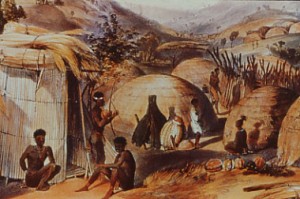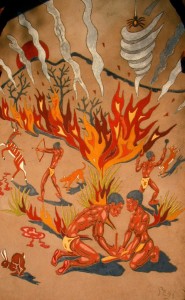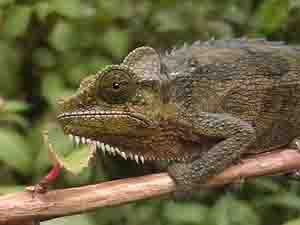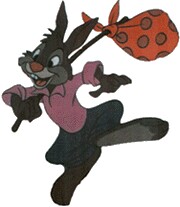The Fantasy Genre has long been dominated by the religions and customs of countries touched on by the Crusades. While this makes sense, with the familiar image of a knight wandering foreign lands being key to the genre itself, there has been stagnation in recent times. As such, I’ve taken it upon myself to look into the cultures of the world and find fascinating details about other mythologies often overlooked by the genre we so love, going on a bit of a tour of world mythologies.
When we last left off, I talked about how Central Africa was home to a variety of cultures that had managed to beat back the wilderness thriving in the heart of the continent. Though details are scant few now, the fact remained that they were still at one time thriving in one of the harshest environments possible. So one would have to ask why these cultures, despite surviving the jungles, would start to disappear over time. During my research, it was difficult to find sources, articles, or even details on the cultures of the Congo. Somehow, they’d slowly disappeared and all signs pointed one direction: The Bantu.
The Bantu people of Central and East Africa, a collection of several smaller groups united by culture and parts of their language, are among the most prosperous of the region. And, as they continued to grow, they gradually started to become the dominant culture in the area. Several smaller religions in the region are generally variations of Bantu and those that are not were eventually phased out in favor of the more prevalent Bantu beliefs. In essence, while these smaller cultures survived the Congo, the Bantu did it better. And, the thing is, their impacts are felt even in the west, where inspirations from Bantu belief eventually bled into the African culture that did reach us on this side of the world.
Through stories which were propagated through much of the south and even eventually adapted by Disney, we’ve come to know of the Bantu indirectly through the stories of “Uncle Remus” and tales of the Brer Rabbit. This figure, which also adopts traits and stories from Anansi and a few Native American tales, happened to be heavily influenced by the Hare of Bantu mythology, making Hare one of the two best known figures of Sub-Saharan mythology in the west. And so, today, let’s take a look at where Hare (and thus Brer) came from.
The Bantu
Bantu mythology is one of the more unique mythologies of the continent. The differences don’t immediately jump out, given more superficial details, but soon become apparent the further you go. On the surface they are monotheistic, animist, and believe in the spirits of their ancestors – all common through the Sub-Saharan regions. But as you go further you find they’re one of the few to not have an importance on lesser spirits, don’t believe that nature spirits are driving everything around them, and believe their souls are finite and even capable of disappearing.
All of these beliefs stem from the fact that the Bantu are one of the only religions on the continent (in fact, one of the few in the world) to not have a creation myth for the Earth itself. In the eyes of the Bantu, the Earth and the animals that lived on it had all been here to begin with and will always be here afterwards. As such, there’s no real need for it to be controlled by an outside force because it is what it was always meant to be. Some spirits may influence nature, maybe even interact with it, but these spirits did not make the things they interact with and don’t have full control over them. To the Bantu, the universe is eternal and anything that is not a member of the Bantu (even other people, in many cases) are just something that has always existed, including…
God
Though now long assimilated with the Abrahamic views of God over time, the original depiction of God by the Bantu is a starkly different figure. Going by many different names assigned by the various subgroups of the Bantu culture, one thing was agreed on by all in it – God did not care. This isn’t that unusual for African cultures, with some cases being more extreme than this, but the relationship between the Bantu and God is best described as “detached”. The Bantu (prior to outside influences) had few rituals or traditions involving the worship of their God, and believed him to not want any interaction with them. In fact, one of the most interesting aspects of this is the fact that their God may have created this distance on purpose – not for the Bantu, but for himself.
God in the Bantu mythology is not a creator deity, merely the ruler of the Earth and all things within the Eternal Universe. And as a part of the Eternal Universe, God existed side-by-side with nature and the animals of the land. In fact, at one point the heavens, the domain of God, were closer to the Earth – so close that an animal which climbed to the top of the tree could reach his domain. And this was the natural order of things, with God existing in harmony with the rest of the Universe and staying close to the animals, which are often referred to in Bantu stories as God’s people.
Then mankind arrived and ruined everything.
Born from plants of the region (trees, bamboo, and the like), mankind joined the Eternal Universe as one of the only things to have an origin. It was the first time something new had entered the natural order and God… wasn’t a fan. Often bothered by the smoke of their campfires or individuals climbing trees to try to enter his domain, God was annoyed with this new creature on his Earth. Even when using pestles, a simple tool, the Bantu managed to annoy God by hitting him in the belly as they would swing their arms up to bring them back down. Finally, having had enough and watching mankind damage the nature he so loved, God had enough and decided to literally separate the two domains by pushing them apart from each other.
That’s right, God bailed because humans are shitty roommates.
The Bantu weren’t really too concerned about this and went about their daily lives. God wasn’t their creator and he didn’t much care for them so the feeling was mutual in a lot of regards. But as he was growing annoyed, God decided to leave them one departing gift that has kept on giving ever since.
Death
There are two creatures in the cosmos which the Bantu see as controlling the forces of life and death. This is not uncommon for African mythology, with a lot of ancient spirits usually doing the deed. But in the Bantu belief, death came to be a thing because of God’s particular choice of messengers: The Chameleon and the Lizard.
These two figures each represent the opposing forces but are both considered bad omens regardless. The Chameleon, slow moving, methodical, and inclined to find some harmony with its environment and blend in, represents eternal life. Meanwhile, other lizards which move by quickly and tend to be disruptive and easier to notice came to represent the forces of death instead. Both of these, despite some obvious symbolism, are for a very simple reason – God said so.
Before mankind had a chance to outstay its welcome, God considered giving the new creatures eternal life to make them a part of that Eternal Universe that he was so fond of. Delivering this message to Chameleon, God sent the little guy to deliver to us the gift of eternal life and membership into the great big Eternal Universe. However, this didn’t last very long because God got to know us, and soon after God sent a second messenger, the speedier lizard, to send us a brand new message that everyone’s gotta die. Unfortunately for us – Lizard won.
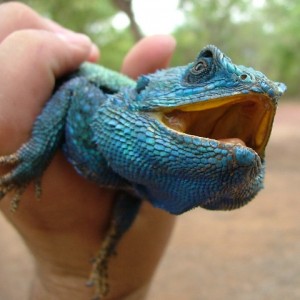
And as a result, we’ve been dying ever since. The Bantu never got over the failure of Chameleon, who was supposedly distracted along the way, and have held it and the Lizard both as ill omens which could bring death.
This isn’t the usual form of death with the permanent loopholes either. Though many religions throughout the world hold that the soul will go on to live for eternity, or be reincarnated into another life, the Bantu see the afterlife as how much of an impact you made on the living world. Spirits of the recently departed will continue to exist in the world and even interact with that world through dreams, visions, or symbols all around. But as people begin to forget the spirit, these entities slowly degrade and disappear over time. Those who made a great impact, such as old rulers or heroes, will live for as long as people remember them, while lesser people will generally disappear entirely within a couple generations.
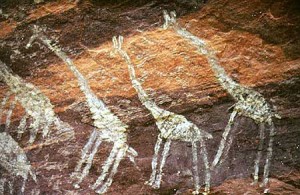
However, it’s not as though God specifically targeted mankind (though, he kind of did), as we’re not the only creatures in the cosmos to face death. And, though the animals of the realm are part of the Eternal Universe, death comes for all of us, even the most cunning among us such as…
Hare
A folkhero of the Bantu in the same way Anansi is to the Akan, Hare is one of the most clever and cunning creatures of the cosmos. Finding clever ways out of all of his problems, Hare went on to inspire stories even here in the west as the Brer Rabbit, a figure which blended Hare, Anansi, and several others before being passed around as folktales through the south. Eventually, Brer Rabbit even went on to be adapted by Disney in a fairly transparent attempt to counter Bugs Bunny.
But the comparison is pretty apt. Hare, and by relation Brer Rabbit, is a trickster who uses his intelligence to try to get one over on every other creature in the animal kingdom. He has a bit of a dislike of authority, often disobeying the likes of Lion or Elephant, and will use his wits to get his way. In fact, the comparison is so close that Hare has been known to create disguises for himself, somewhat quickly put together and using what materials are on hand, in order to trick his adversaries or just get his way – a trait long known by fans of Warner Bros.
Hare’s opposition is a little different than that of the cartoons of the modern day, however. Hyena, an animal known to represent deception, was actually something of a friendly but violent rival. The two shared a knack for underhanded tactics and would often come into conflict trying to outdo each other. However, as time went on the relationship somewhat soured due to forces beyond their control. A great famine swept through the lands and the two animals were faced with a problem. With little to eat, Hyena felt it was necessary to kill and eat his own mother, something he believed Hare should do as well. Hare agreed to this in person, but soon tried his best to hide his mother away.
As time went on and the Hyena had finished eating his own mother, he started to become aware that Hare was somehow eating regularly. His mother, having more skill at surviving in the famine, had been feeding Hare the entire time with what little they could manage. Hyena, discovering this, felt betrayed and decided there was only one thing to do – eat Hare’s mother. What was once a friendship had become a bitter rivalry. Hare, wanting revenge for his mother, soon fooled the Hyena into thinking that he could be granted riches and power by submitting to an odd ritual involving a red hot iron. Hyena, trusting the friend and wanting the riches he was promised, submitted to it only to have that red hot iron driven into his head.
And there-in lies one of the great weaknesses of Hare. While one of the most clever and cunning of the animal kingdom, he was also usually convinced there was always a way out. Hyena was bound to eat Hare’s mother (or Hare himself) if ever discovered, but Hare thought he’d found a loophole. And some things can’t be undone, no matter how you may think it could. While skilled at figuring his way out of things, he always thought there would be a way out even if it sounded like a bad idea. This was unfortunately the thing that led to his end, as Hare came to misunderstand the nature of death itself in what is greatly considered to be his canonical end.
On one occasion, clearing after killing Hyena, Hare went to visit his friend the Cock only to find that his friend appeared to have no head attached. In truth, Cock was sleeping with his head tucked under his wing and Hare had simply never seen it before. But as Hare poked him and Cock’s head sprung back out, Hare was shocked to see his friend return from the “dead” and regrow his severed head. Cock, amused by it, joked that it was a simple trick that all you had to do was hit a decapitated body to bring it back to life and joked that Hare should try it. And, like his lack of understanding of the nature of Hyenas, the normally clever Hare didn’t much understand Cocks either and took his friend seriously. Excited to try this new trick, Hare instructed his family to remove his head and strike him to bring him back to life.
Unfortunately for him, Hare’s family was as oblivious to the rest of nature as he was in this case and soon followed his instructions (though with much more hesitation than he had himself). They removed his head, carried it away, and attempted to bring him back only to see it wouldn’t work. Cock, concerned he hadn’t seen his friend in a while, soon came to see the body and realized something that no one else had realized before: Hare might have been stupid. But, while Cock questioned Hare’s intelligence, he really was clever and quick to think on his feet. But, while accustomed to finding ways out of problems rather quickly, the lesson in the end…
Is that sometimes there’s no way out of it.
(I write novels and have a twitter account. Please read them, else I be forgotten!)



